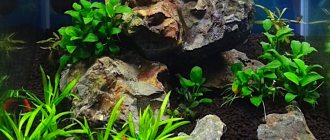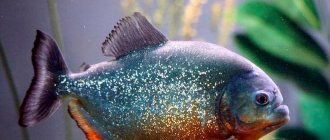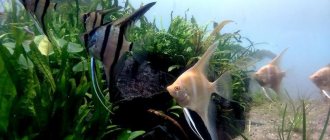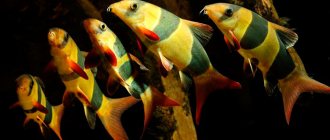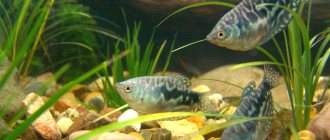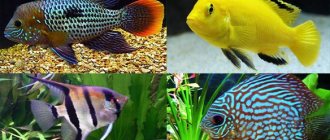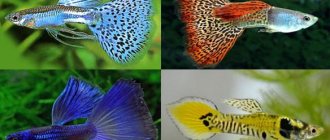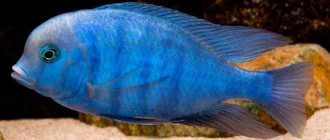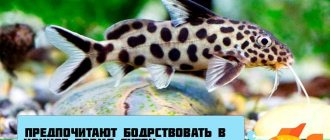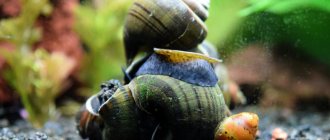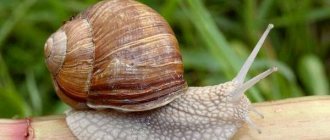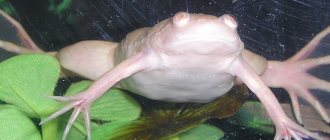Aquarium shrimp belong to the family of crustaceans, which are characterized by enormous endurance and adaptability.
Instead of claws, shrimp have three pairs of jaw legs, which are responsible for movement, long antennae and a powerful tail. The shrimp's body is covered with chitin. Shrimp are excellent at navigating in an aquarium due to their ability to rotate their eyes.
Aquarium shrimp are kept in special freshwater aquariums with clean and well-settled water, since shrimp are very sensitive to any chemical composition of water.
Types of aquarium shrimp with descriptions and photos
Shrimp are not only a decoration for any aquarium, but also aquarium orderlies. Crustaceans became pets only recently, but have already gained immense popularity among both beginners and experienced aquarists.
Recently, many different types of aquarium shrimp have been bred by experienced breeders. There are several such types. Let's look at the most popular types:
Shrimp Cherry or Cherry
Cherry or Cherry is one of the most common species throughout the world, which was bred by breeders from Germany.
It reaches a length of about 4 cm, life expectancy is on average 1-2 years.
The size of the aquarium is from 5 liters for 10 individuals, but for comfort it is better to have 1 liter for 1 Cherry shrimp. They can live at temperatures from +14-30˚С, but a comfortable temperature is from +22-25˚С, acidity from 6.5-8 pH, hardness from 3-10° dH.
Cherry is omnivorous, eats: zoo- and phytoplankton on moss, dead parts of plants, corpses of small fish, shrimp pellets, live and frozen food, lightly boiled vegetables.
Blue Dream
Blue Dream, the shrimp was named so because of its brightly saturated, very beautiful blue color. The maximum length of a female is 3 cm, a male is 2 cm. Females are larger than males and much brighter in color. Very unpretentious in breeding and maintenance, suitable for breeding for beginning aquarists.
It feeds on aquarium algae and the remains of flakes of fish food, feeding once a day with dry food for shrimp or bottom fish.
Temperature for keeping from +22-26° C, acidity from 6.5-8 pH, hardness from 5-18° dH. When kept in the required conditions, the lifespan is up to 2 years.
Cardinal
The Cardinal shrimp reaches 1.5-2 cm. Natural habitat of the lake of the Sulawesi islands, Indonesia. The content of Cardinal is quite complex, since its maintenance requires a temperature of +26-29°C, acidity from 7.8-8.2 pH, potassium hydride from 7-9 kH, alkalinity from 7-9 gH, water salinity from 90-140 TDS, hardness 7° dH.
The substrate should be soil with a size of 3-4 mm with an abundance of aquarium plants and especially mosses. There is also an abundance of stones that serve as a home.
Life expectancy 1 year.
Riley
The Riley shrimp is one of the most unpretentious aquarium crustaceans. To maintain it, you need a temperature of +18-28° C, acidity from 6.5-7.5 pH, hardness from 4 to 14° dH. If all maintenance requirements are met, the lifespan is 2-3 years.
One Riley requires an aquarium of at least 1 liter. The size of an adult female reaches up to 2-2.5 cm, the size of a male up to 1.5 cm.
They feed on: algae, dead and rotting plants, fish food. For reproduction there must be clean water and all maintenance requirements must be met.
Far Eastern shrimp
The Far Eastern shrimp is an aquarium orderly with a transparent shell and dark transverse stripes, but the color depends on the color of the food and the shade of the substrate. It reaches 4-5 cm in length.
The Far Eastern omnivore feeds on aquarium algae, dry and live food, and vegetables (carrots, cucumbers). Can help in the fight against thread. He can also eat his own kind - a cannibal. When threatened, it can voluntarily drop its paws. But during molting, the limbs are regenerated.
You can run 10-15 individuals per 100 liters. An important factor in terms of content is oxygen in the container and filtration. The temperature can be from +18-30° C, but a comfortable temperature is from +20-24° C, acidity from 5.5-7.5 pH, hardness 10° dH, and kh 3 - 6.
Red, black crystal
Shrimp red, black Crystal is a real striped aquarium cleaner. This species was nicknamed for its bright color, consisting of alternating white and red (or black) stripes across the shell. Crystal was developed in China.
The size of the female Crystal shrimp is 2.5 cm, the size of the male is 1.5-2 cm. Recommended for breeding by experienced aquarists.
Crystal feeds on aquarium algae. An excess of protein is detrimental for this shrimp, so it is not recommended to frequently feed it with live food. The ideal food is a specialized shrimp food.
Temperature for keeping from +21-26° C, acidity from 6.5-7.5 pH, hardness from 4-6° dH. Life expectancy, subject to maintenance conditions, is 1.5-2 years.
Filter
The Filter shrimp is very different in appearance from other crustaceans; it has cilia-fans on its claws, with which it feeds. The filter finds the strongest current near the filter and catches microorganisms, plant remains, etc. with its cilia.
The size in captivity is from 6-10 cm. In the wild, the size of the female reaches up to 20 cm, and the male up to 18 cm. For a small flock you need an aquarium of 40-60 liters.
The water temperature should be from +23-29° C, acidity from 6.5-7.5 pH, hardness from 4-8° dH. Life expectancy is from 1.5-2 years.
Glass Shrimp
The Glass Shrimp is very beautiful, with a transparent shell reaching a length of no more than 4 cm.
Glass is in constant search of food. It feeds on fish food, specialized food for crustaceans, and loves live food such as bloodworms and tubifex.
One individual needs an aquarium of 4 liters. Water temperature from +20-28° C, acidity from 6.5-7.5 pH, hardness from 4-8° dH. Lives from 1 to 1.5 years.
Black Tiger
The black tiger or black diamond shrimp was bred by breeders in Japan from the common tiger shrimp. There are two types of black tiger shrimp, the first type with black eyes and the second - the most valuable type - with orange eyes. In captivity, the maximum size of a female is up to 3 cm, the size of a male is up to 2.5 cm.
It feeds on dry aquarium food for crustaceans or fish. Water temperature from +17-23° C, acidity from 6.5-7.2 pH, hardness from 2-10° dH. Life expectancy is from 1.5-2 years.
Red-Nosed Pinocchio
The red nose shrimp Pinocchio lives in a group of 6 or more individuals. For a group you need an aquarium of at least 30 liters in size. Male Pinocchio grows up to 4 cm, females up to 5 cm. Comfortable keeping conditions:
- temperature from +24-30° C;
- acidity from 6.5-7.5 pH;
- hardness from 8-15° dH.
Pinocchio, like the Far Eastern one, can regenerate limbs. If for some reason Pinocchio lost his nose, then thanks to regeneration the nose will grow back.
As environmental conditions worsen, Pinocchio changes from a transparent color to a milky hue.
Babaulti green
Babaulti green in the wild grows up to 4 cm, in captivity up to 3 cm. Comfortable temperature will be from +22-28° C. Acidity from 6.5-8 pH. Hardness from 8-20° dH. The volume of the aquarium is from 5 liters per individual. If the maintenance conditions are met, green Babaulti lives for 2-3 years.
Compatible in the aquarium with all small non-aggressive species, crustaceans, colorful fish and snails.
Macrobrachium
Macrobrachium means “large-armed” in Greek. Macrobrachium uses long claws to capture food, fight for territory, and hold the female during mating. The organ of touch is developed due to long antennae.
In the wild, the size can reach up to 30 cm. In captivity it grows up to 20 cm. Macrobrachium live in flocks and in such a flock there is a dominant male, so the capacity should be from 10 liters per individual and there should be shelters.
The most common colors are yellow, blue, black, but as they grow, the color may change to the color of the ground.
Conditions in the container: temperature from +20-32° C; hardness from 6-15° dH; acidity 6.5-8.5 pH. Duration in container up to 4 years.
Amano
Amano reaches 6 cm. The color depends on the food it eats. They live from 2 to 3 years, but there have been cases when they live for 5-6 years.
Amano live in flocks of 10 or more individuals. For 1 individual you need 5 liters (this is for comfortable living). Temperature from +23-27° C; acidity from 7-7.5 pH; hardness from 2-20° dH.
If there is a precedent for a mass escape, then you need to pay attention to the environmental conditions.
Gets along with all non-aggressive species.
Aquarium equipment
Decorative species of shrimp can be kept in spacious glass aquariums. The minimum volume of an artificial reservoir should be about 50-60 liters in order to avoid overpopulation, which is fraught with manifestations of aggression and conflict situations among its inhabitants.
You will also have to take care of purchasing a powerful filter, aerator, and bright and intense artificial lighting. Additional oxygen supply will also be required. Experienced specialists recommend using a specialized closed water supply system for these purposes, which automatically regulates all the main indicators, including lighting. Such equipment is not cheap, but it allows you to grow shrimp for a whole year without putting in almost any effort.
It is recommended to decorate the bottom of an artificial reservoir with tiles or stones. They will serve as a kind of shelter necessary for representatives of crustaceans to create optimally comfortable living conditions close to the natural environment and reduce the stress factor that negatively affects the condition and growth processes of the shrimp.
Separately, it should be noted such an aspect as the temperature regime.
Shrimp do not tolerate low temperatures very well - when the temperature drops to +15°C, the activity of individuals decreases significantly and the processes of growth and reproduction completely stop.
However, overheating is much more dangerous for shrimp. When the temperature of the aquatic environment rises to +32°C and above, the process of protein coagulation begins, leading to the inevitable death of animals. In addition, like other crustaceans, these pets are sensitive and susceptible to sudden temperature changes and changes in water parameters, so if you want to change the climate in the aquarium, this should be done smoothly and gradually.
What to feed an aquarium shrimp
Shrimp eat absolutely everything; they are the so-called omnivorous aquarium cleaners.
These underwater inhabitants are always in search of food. They eat aquarium algae, dead parts of other plants, dead fish, live food, lightly cooked vegetables and even particles of organic waste that remain on the walls of water purification filters.
Also, no more than three times a week, shrimp can be fed with any shrimp food, such as dried daphnia or tetra.
How to choose the right type for your home
You need to choose the type of shrimp to keep taking into account the experience of the aquarist. The easiest way is to create conditions for freshwater shrimp.
If there is no experience in keeping such animals, it is better to give preference to species bred through selection. These shrimp are better adapted to the aquarium.
How to distinguish a female from a male and how to breed
Determining the sex of a shrimp is quite easy; usually the female is much larger than the male and has a curved lower abdomen, a saddle on the back and a darker or richer color.
To reproduce, you don’t need to make any effort at all; they cope just fine on their own. During the breeding season, the female secretes certain enzymes into the water, and the males, sensing these enzymes, rush around the aquarium in search of her. Mating between a male and female lasts only a second. After mating, the female has fertilized eggs, first on her back, then they smoothly move to her abdomen, and after 3-4 weeks the fry appear.
Aquarium crustaceans require constant movement of water in the tank for proper ventilation of the eggs. Under conditions of properly organized water flow in the aquarium, the risk of embryo death due to damage by bacteria and fungi is reduced.
Spawning tank
To ensure that the young animals do not become an addition to the diet of other inhabitants of the aquarium, the female shrimp is placed in a separate container from the fertilization process until the young animals can live independently.
For successful spawning of crustaceans, the following conditions must be provided:
- clean water with a temperature from +15 to +30 С;
- slightly acidic or neutral pH level;
- absence of copper and nitrogen compounds;
- aeration;
- if possible, at least a small movement of water should be organized;
- a lid so that particularly active individuals do not have the opportunity to jump out or escape;
- plants with small and small leaves.
Under unfavorable conditions, shrimp can change sex. This phenomenon is called hermaphroditism.
If you contain several breeds of crustaceans in one container, you can get unwanted offspring from crossing different species. Such individuals are considered “mutts.” They rarely inherit the beautiful color of their shell.
In order to breed amano shrimp, the spawning tank must have salty sea water. Other types of crustaceans do not require this condition.
Pairing
Between the female's molt and the laying of her eggs, fertilization occurs. The soft shell allows for mating. The female begins to secrete pheromones that attract males. During sexual intercourse, the boy attaches sperm packets to the female's genital opening. After this, the female looks for a secluded place, lies down sideways and bends her abdomen in such a way as to create a space into which the eggs fall. The eggs themselves are fertilized at the moment they emerge from the genital opening. Each of them passes through a sperm packet.
Shrimp mating often occurs in the evening and at night.
Between sexual intercourse and the laying of eggs, it can take from several days to two weeks.
The number of eggs and, accordingly, fry depends on the age and size of the female. The bigger and older she is, the more offspring you can expect from her.
Pregnancy
Pregnancy depends on the species and conditions in the aquarium, but most often lasts about 30 days. During this period, the shrimp ventilates the eggs, sorts them out and throws away the defective ones. In most species, the fry hatch at the same time. They resemble miniature adults and are capable of independent existence.
Shrimp eggs are securely attached to the female's abdomen.
Compatibility of aquarium shrimp with other fish
Aquarium shrimp get along well with small, non-aggressive fish species, such as:
- Guppy;
- Pecilia;
- Danio;
- Neons;
- Neon irises;
- Parotocinclus.
It is strictly recommended not to add large predatory fish, large Cichlids such as Maingano, Angelfish, Apistogramma, to shrimp, since these types of fish can eat shrimp and it is recommended not to add predatory Helena snails.
Conditions for reproduction
If you create favorable conditions, the reproduction of aquarium shrimp will not cause any problems. To do this, you need to create a secluded corner in the aquarium with Java moss and small-leaved plants.
As soon as the shrimp become active and chase each other, it means that the female has reached puberty, and mating games have begun . Sometimes she goes to several males and then bears large offspring. The greenish mucus under the tail is eggs. Small, translucent shrimp can be seen maturing. When the visual apparatus is formed during gestation, black eyes in the eggs will be visible.
On average, after 5 weeks, the eggs hatch into larvae. This process is very entertaining. Different species do not interbreed.
Currently, shrimp farming in aquariums is popular.
Shrimp diseases
Aquarium shrimp are highly adaptable, so they are least susceptible to disease. But most often they are carriers of bacteria and harmful microorganisms. If not properly cared for, aquarium shrimp can harbor certain types of parasitic creatures, such as:
- Suvoiki (Vorticellidae);
- trumpeter ciliates (Stentoridae);
- parasitic worms of the genus (Scutariella);
- parasitic algae (Cladogonium ogishimae).
Treatment of shrimp is not required, you just need to eliminate the cause of bad water and improve living conditions.
general characteristics
Homemade shrimp in an aquarium look very aesthetically pleasing and are a decoration for any artificial tank . There are a huge number of species of these crustaceans of all kinds of colors. Many species are quite accessible to aquarium owners. But there are very large aquarium shrimp of rare and valuable species, the cost of which is fabulous.
Appearance
Several segments make up the body of a shrimp. Each such department has its own limbs that perform various actions. The first three segments of the body have a shell that performs a protective function. The jaws, whiskers and mandibles are limbs.
The shrimp has a complex mouthparts of a certain size. It contains three pairs of jaws that grind food, which it holds with its jaws. The remaining five pairs of thoracic limbs are used by arthropods for crawling and catching prey.
To swim, they use abdominal legs called pleopods. Females use them when bearing eggs. And the first pair in males is the copulatory organ.
Habitats
Under natural conditions, these arthropods are found almost everywhere - both in salt water and freshwater. But each species has its own place of birth. For example, the Amano species comes from Japan, where it is found in mountain rivers flowing into the Pacific Ocean.
The birthplace of the rednose shrimp is Venezuela. In the Pacific Ocean off the coast of Panama, a fan-shaped species of these crustaceans is found. Babaulti's habitat is India. Most of the ornamental freshwater shrimp in the aquarium are native to Asia. In Russia, they live in the Far East, where there are more than 100 species. There are about two thousand species in their family.
In natural conditions, shrimp are found almost everywhere
Habitat in nature
In fact, it is a color variation of common neocardinas, bred by selecting and enhancing the bright colors. Neocardines are distinguished by their inconspicuous, camouflage coloring, which is not surprising; they cannot survive with cherry blossoms in nature.
By the way, neocardines live in Taiwan, in freshwater bodies of water, and are distinguished by their rare unpretentiousness and speed in breeding. These were the first of the shrimp that began to appear in large quantities in the post-Soviet space, but gradually they gave way to cherry shrimp.
At the moment, shrimp lovers have developed a whole quality classification, which is based on the size and color of the individual; elite cherry shrimp sometimes cost a lot of money.
How much money do you need to start a business?
The amount of investment in this business depends on the type of shrimp you will breed and the scale of production. To grow aquarium representatives, 20-40 thousand rubles are enough, but for mass breeding of shrimp, which are eaten as food, more investments will be needed. Below is an approximate list of costs for starting a business:
| Expense item (per year) | Cost in rubles |
| Purchase of young animals (1000 pcs) | 40 thousand |
| Equipment | 760 thousand |
| Renting premises | 190 thousand |
| Purchase of feed | 155 thousand |
| Salary (2 employees) | 350 thousand |
| Communal payments | 160 thousand |
| Other expenses | 55 thousand |
| General expenses | 1,710 thousand |
You may be interested in: Dog walking business - how to combine business with pleasure
In total, starting a business on an industrial scale will cost approximately 1.7 million rubles. In this case, you can expect to receive 5 tons of products.
Decorations for shrimp
It is better to select natural sand of the 2-3 mm fraction as a primer for the shrimp tank; it is better to avoid artificial colored soils. You can and should decorate an aquarium with shrimps with stones; you can buy natural driftwood in the store. Or you can prepare it yourself. You can read how to prepare stones here, and about driftwood here.
Driftwood "desert tree"
Let’s also not forget about the plants mentioned above. It is better to plant long-stemmed plants in a bunch of several stems, so that lush thickets will form over time. Various types of ferns are perfect, and many mosses, anubias and other plants look great.
Behavior
Cherry shrimp are completely harmless, and if you see them eating a fish, then this is the result of natural death, and the shrimp only eat the corpse.
They are active throughout the day and can be seen moving around plants and decor in search of food.
Cherry shrimp regularly molt, and the empty shell lies on the bottom or even floats in the water. There is no need to be afraid, molting is a natural process, as the shrimp grows and its chitinous suit becomes tight.
You don’t have to remove it; the shrimp will eat it to replenish their supply of substances.
The only thing is that during molting they need to hide, here moss or other plants come in very handy.
